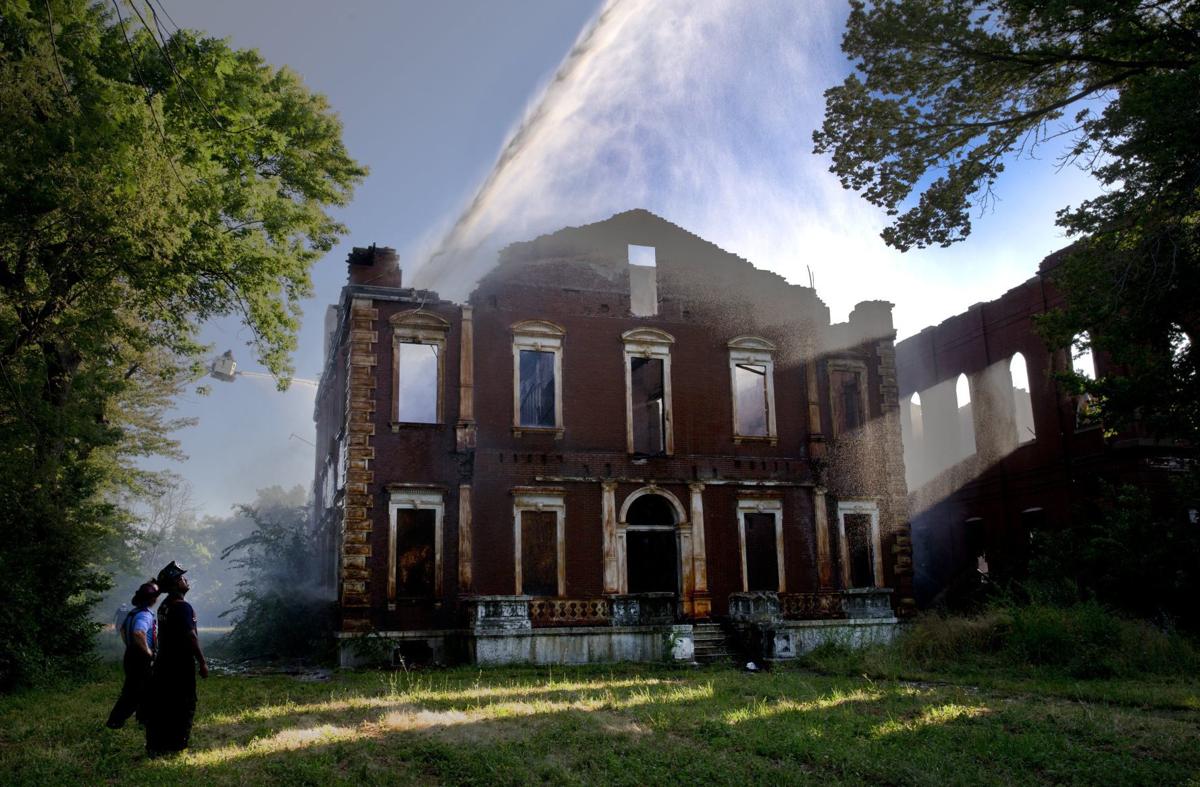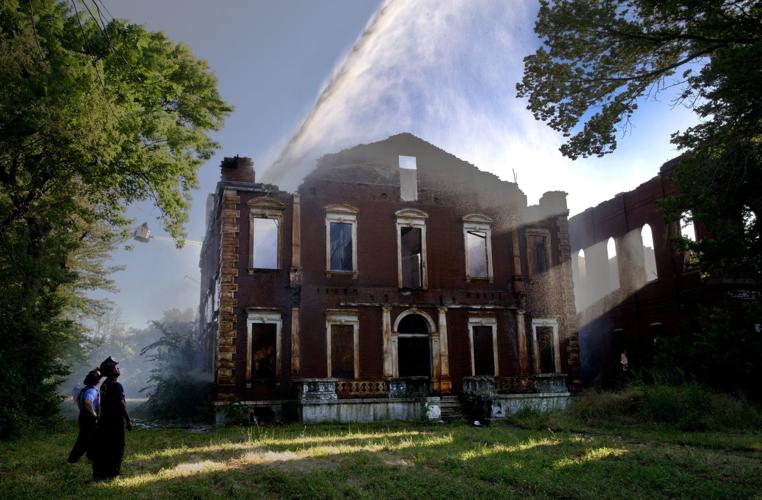ST. LOUIS — In July 2017, the Clemens House, an 1860 Greek revival home built north of downtown by a relative of Mark Twain, burned. The fire’s cause was ruled undetermined and not investigated further.
In 2021, the seven-story bell tower at a century-old church on a prominent Central West End corner went up in flames. Fire officials and an insurance investigator said it was likely due to a homeless person trying to keep warm inside.
In October 2022, a warehouse protected from demolition in a swath of the North Riverfront neighborhood eyed for redevelopment burned down. A nearby old factory that was also on the National Register of Historic Places soon followed.
People are also reading…
In May 2023, a warehouse that was part of a historic manufacturing complex on North Seventh Street caught fire and was destroyed. Then, in September, the Mullanphy Emigrant House, built in 1867 to aid the city’s booming immigrant population, was engulfed by flames.
After two more suspicious fires in recent weeks — a January blaze at a law office in Tower Grove East and a fire that engulfed another historic warehouse north of downtown, drawing the attention of federal investigators — some St. Louisans are questioning how good a job the city’s fire and police departments are doing to identify and charge the people responsible.
In many cases, the buildings that burned had languished for years, with owners unable or unwilling to finance repairs but barred from tearing them down because of the city’s historic preservation ordinances.
“If you can’t get a demolition permit, then that creates a motive,” said Andrew Weil, executive director of the Landmarks Association of St. Louis. “And if people know, or at least the perception seems to be, that for an uninsured building, or for a building where there’s no immediate victim, that these big fires will just be chalked up to vagrants.”
The Bureau of Alcohol, Tobacco and Firearms has not opened a formal criminal investigation, but it has been probing the Feb. 3 fire that destroyed a warehouse at 1230 North Second Street in the North Riverfront. An adjacent vacant warehouse with the same ownership — the McGowan family that was known for years for its Washington Avenue rehabs — burned in October 2022. Both were historic structures protected from demolition and sat in an area a nearby landowner hopes to redevelop.
Fire officials and building owners say there’s no doubt homeless people break into vacant buildings and may try and keep warm with fires that get out of control. Vandals could also be involved. But vandals and the homeless aren’t sought by authorities either.
Weil argues there needs to be some sort of deterrence in the form of investigation, or at least rigorous code enforcement, if the city wants to prevent more fires that could endanger the lives of its firefighters.
“We don’t know if that’s the case, if there is something nefarious going on,” he said. “However, I would argue the problem of unsecured or improperly or insufficiently secured vacant buildings is really at the root of all of this. And that falls back on code enforcement; it falls back on the expectations the city sets for property owners.”
The owners of the buildings say homeless people and scrappers break into the buildings constantly, even after they have been secured.
“Every day, we battle with homeless breaking in and out of these buildings,” Tim McGowan said of the warehouses his family owned in the North Riverfront. “We’ll board it up, and an hour later, they’ll have gained entry again.”

"I wanted to restore it and start a urgent care clinic," said owner Wahied Gendi, an emergency room physician, who evaluates the damage from a fire on Friday, Sept. 15, 2023, that collapsed former Mullanphy Emigrant Home at 1609 N. 14th St. in the Old North neighborhood. Gendi bought the property in late 2018. The Mullanphy Emigrant Home, completed in 1867, offered charitable housing to incoming Irish immigrants. Photo by Laurie Skrivan, lskrivan@post-dispatch.com
Wahied Gendi, a doctor who bought the Mullanphy Emigrant House in 2018 with plans for a rehab, described the trespassers as resourceful and persistent. They used power tools to get past special locks and climbed in through windows to scrap wood and other material from the interior of the structure before it caught fire last year.
“I called the police like five or six times,” he said Friday. “That’s what I hear from neighbors, a lot of people getting in and out.”

The charred bell tower of a vacant church is seen Oct. 26, 2021, after it went up in flames overnight. The Second Baptist Church building at 500 North Kingshighway is among four places of worship at the intersection of Kingshighway and Washington Boulevard, known as the “Holy Corners,” which was granted official landmark status by the city of St. Louis.
Gurpreet Padda, who has owned the vacant Second Baptist Church on Kingshighway for more than a decade, said fire officials indicated the blaze that destroyed the bell tower was likely from a homeless person trying to keep warm. A private investigator said blankets and clothes indicated squatters were staying in the building, according to a St. Louis Fire Department report obtained under a Sunshine Law request.
“The bigger issue is that just as fast as buildings are secured, vandals and homeless break in again, as they have no place to go, and they are aware that the police will not incarcerate them,” Padda told the Post-Dispatch in an email.
Padda is in litigation with his insurer over a $2.5 million payout he says he is owed from the insurance company, which paid him just $875,000. Among the reasons the insurance company says it doesn’t owe any more is that Padda “declined any mitigation attempts to further protect the property,” an allegation Padda denied.

Jim Meiners (left) of the City Museum and Carlos Mendoza remove an 800-pound cast iron window frame containing image of Eliza Clemens, from the Clemens House in the 1800 block of Cass Avenue on Monday, Feb. 12, 2018. The house, built by James Clemens (a relative of Mark Twain) as a tribute to his wife, burned last July. Staff members from the museum, which collects historic St. Louis architecture, are removing the cast iron structures before its upcoming demolition. Photo by Robert Cohen, rcohen@post-dispatch.com
Paul McKee, whose NorthSide Regeneration owned the Clemens House and the Seventh Street warehouse that was part of the historic Sligo Iron complex, said neighbors saw a “young man” running from the Clemens House fire scene in 2017.
But that fire and the other high-profile fires in historic buildings were never referred to the St. Louis Regional Bomb and Arson Unit, a police unit that investigates suspicious fires. St. Louis police spokeswoman Evita Caldwell said the unit only gets involved if the fire department, which conducts initial fire cause assessments, refers fires to police that it believes are “suspicious in nature.”
The arson unit has investigated about 375 fire cases since 2021 and applied for charges 26 times, Caldwell said.
The St. Louis Fire Department’s chief fire investigator, Capt. Calvin Stewart, said the vacant historic buildings that have burned in recent years were all classified as “undetermined” fires that had “extreme fire presence that went to multiple alarms.” The fires burned up the ignition sources and any other contributing factors, and the amount of water used to extinguish them added to the fire damage, making the buildings unsafe for firefighters and investigators to enter.
“The area of origin and ignition source is critical for any successful origin and cause investigation,” Stewart said in an email. “Without it, it isn’t easy to locate potential evidence that could be associated with a criminal act, which is needed for the detectives of the bomb and arson Unit.”
‘No question that this was arson’
At 4 a.m. on Jan. 25, attorney Jonathan Beck’s law office, on a prominent corner in Tower Grove East, went up in flames.
The building at 3500 Magnolia Avenue had been a historic rehab, an old grocery store turned into law offices. Beck and his partners worked there for more than a decade.

Jonathan Beck arrived at his law office in Tower Grove East the morning of Jan. 25, 2024, to see this. “I put my heart and soul into rehabbing and improving that building over the last 14 years,” said Beck.
Surveillance video of his building, which he shared with the Post-Dispatch, recorded the fire starting. Before flames are visible, glass can be heard breaking. Witnesses saw a utility truck in the alley around the time of the fire. The electric panels were fine, Beck said, so it didn’t appear to be electrical. And after the fire breaks out on the video, Beck said, it looks like flames are coming from the sidewalk.
“I’m no fire investigator, but it indicates to me that someone was breaking into the building to pour gasoline all over this place,” he said. “Which further explains why, three minutes into this video, you see an explosion, you see fire shooting out of the windows, you see the sidewalk on fire.”
A day or two after the fire, he heard from Stewart at the fire department.
“Stewart was very kind,” Beck said. “But mostly his message was: We’re not really going to do anything. It’s the police’s job to investigate.”
The fire department did a great job quickly putting out the fire, Beck said. But Stewart indicated it couldn’t do much beyond that.
“What Capt. Stewart was sort of saying was: We don’t even have the equipment we need to investigate a fire; we don’t have the ability to do it,” Beck said. “How do you argue with that? I mean that seems like a problem.”
Beck isn’t the only property owner who has been frustrated by the lack of investigation after a fire. In 2016, Jason Deem, a developer who focuses on buildings around Cherokee Street and surrounding neighborhoods, had one of his buildings on Chippewa Street go up in flames. There had been a rash of fires in the area.
But fire department personnel told him they didn’t plan to dig much deeper into the cause.
“They said since the building was uninsured they didn’t consider it to be suspicious,” Deem said.
Deem had been planning a restaurant in the Chippewa Street building. It still sits vacant.
“I would love to see more resources put toward (fire investigations),” Deem said. “These are the kinds of places we can’t afford to lose. That’s our identity as a city.”
Back in Tower Grove East, Beck received the fire department report on his building earlier this month: “undetermined” was listed as the cause.
Beck complained loudly online about the lack of investigation, and the about the incident.
Then, a day after the article published, investigators from the police bomb and arson unit showed up. It had been a week since the fire. They looked at the property and interviewed his law partner. Beck told them about a potential suspect and some witnesses from the neighborhood. He’s not sure if they’ve looked at the suspect, but they have interviewed at least two witnesses, Beck said.
Now, it’s been more than two weeks since he heard from police. He’s not holding out hope they crack the case.
“In my mind, there’s no question that this was arson,” Beck said. “It’s a property crime, but it’s a really violent property crime.”
“Somebody who’s capable of that,” he added, “is capable of significant violence.”
A demolition crew pushed down a walls from a burned warehouse north of downtown St. Louis into an electric transmission line causing an explosion as Bellon Wrecking demolished the remains of the fire damaged building on Friday, Feb. 9, 2024. Video by Laurie Skrivan, Editing by David Carson/������Ƶ
A wind-fueled fire rips through a warehouse Tuesday, Oct. 25, 2022, near the St. Louis riverfront. Video by David Carson, ������Ƶ.


















